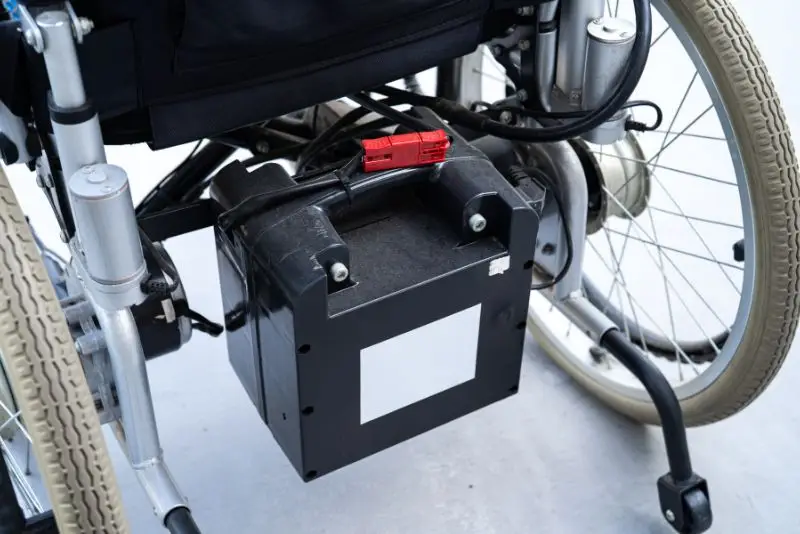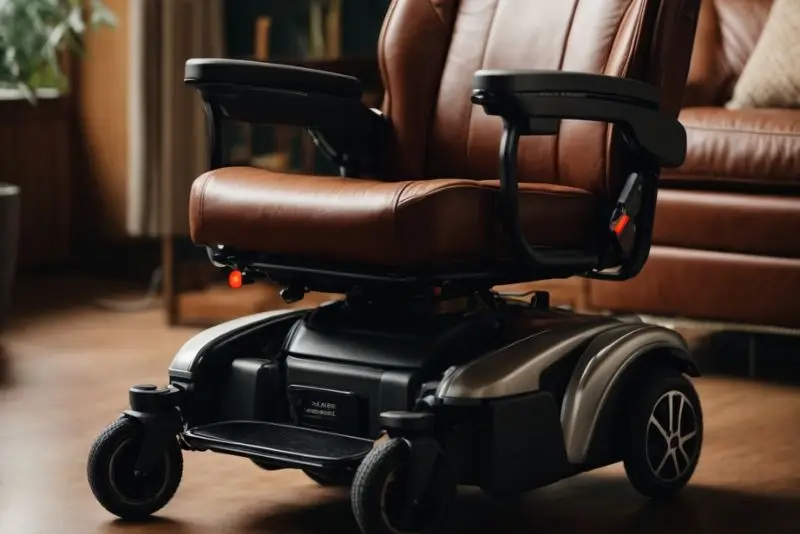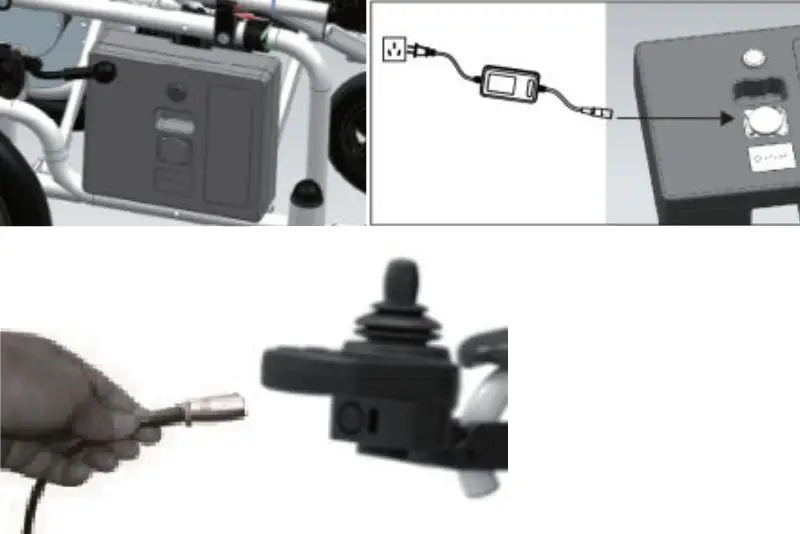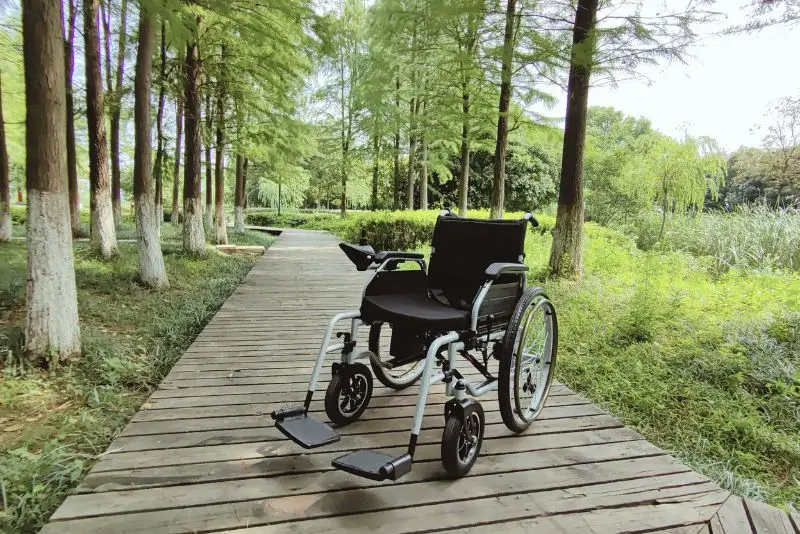Many users face the common issue of low battery life in their electric wheelchairs. They often wonder how to charge an electric wheelchair for optimal performance. This article provides a complete guide on proper charging techniques, ensuring you get the most out of your electric wheelchair.
Keep reading – power up your knowledge!
Understanding Electric Wheelchair Batteries

To ensure your electric wheelchair performs at its best, it’s crucial to grasp the essentials of battery types and care. Knowing how to maintain and when to replace these power sources can significantly enhance their lifespan and reliability for daily use.
Types of batteries (Lead-acid, Lithium)
Electric wheelchairs need powerful batteries to run. There are two main types: Lead-acid and Lithium.
Lead-acid Batteries:
- Lead-acid batteries are a safe and reliable power source that is affordable and easy to replace.
- However, they may take longer to charge and have a shorter lifespan compared to lithium batteries.
- Most power wheelchairs, like our ET300 Budget Electric wheelchair, use sealed lead-acid batteries.
- They need regular charging to keep their lifespan long.
- Replacement should be considered every few years.
Lithium Batteries:
- These are lighter than lead-acid batteries.
- Lithium-ion batteries charge faster and last longer on a single charge.
- They don’t need as much maintenance as lead-acid types do.
- Their lifespan is usually longer which makes them a bit more costly upfront.
- Proper disposal is important because they contain hazardous materials.
Lifespan and maintenance
Electric wheelchair batteries need regular care to last longer. Deep-cycle batteries can keep a motorized wheelchair rolling for up to three years, but only if you don’t use it daily.
If you do, expect to change them every year instead. The key is how often and how well you charge the battery. Always follow the maker’s guide for charging.
Batteries also live longer when they stay in good shape and clean environments. Wet-cell batteries might require more attention than lithium ones but both need checking. Avoid exposing them to extreme temperatures as that shortens their life too.
Make sure connections stay tight and corrosion-free for best performance. Regular maintenance checks help catch problems before they grow bigger, keeping your scooter running smoothly.
Replacement options
Battery replacement is a key part of maintaining your electric wheelchair. The right choice can keep your chair running smoothly for years.
- Determine the type of battery your wheelchair uses. Lead-acid batteries are common, but some chairs may require lithium batteries.
- Match the voltage and capacity specifications. Look for a battery that matches the original specs to ensure compatibility.
- Purchase from a reputable dealer. Find a dealer who offers quality batteries and backs them with a warranty.
- Consider buying two batteries. Keeping an extra one ensures you always have a charged battery ready.
- Recycle the old battery properly. Most dealers will recycle your old battery for free when you buy a new one.
- Check for bulk purchase discounts if you’re buying multiple wheelchairs. This can save money for businesses needing several batteries.
How to Charge an Electric Wheelchair: Step-by-Step

Charging an electric wheelchair shouldn’t be a hassle—if you know the right steps. Dive into our easy-to-follow guide that breaks down the charging process, from battery preparation to the final unplug, ensuring your chair’s power system remains in top condition for seamless mobility day after day.
Preparing the battery
Before you start charging, check the battery’s condition. Make sure it’s clean and free of any debris. If it’s a new battery or hasn’t been used for a while, give it a full charge before using your electric wheelchair.
Always use the charger that came with your chair or one approved by the manufacturer. This ensures that you’re matching the battery specifications and not risking damage.
Find a dry place near an electrical outlet to set up for charging. Keep your workspace clear of clutter where you will connect the charger to your wheelchair’s batteries. Check that cables are untangled and in good shape without any breaks or frays that could pose risks.
Now, ensure both 12-volt sealed deep-cycle batteries are ready for power rejuvenation – this regular attention contributes greatly to their overall lifespan and reliability when powering your mobility aid.
Connecting the charger
Turn off the controller power on the electric wheelchair before you start. This makes sure it’s safe to connect the charger. Find the charging port on your wheelchair, usually located on the base or side.
Grab your battery charger and fit its connector into this port firmly. Ensure it is in place so that charging will be smooth.

Next, plug the other end of your charger into a nearby power outlet. Make sure it’s securely plugged in for a good connection. The battery chargers should have an indicator light to show they’re working.
Watch for this light to confirm everything is correctly set up and charging begins.
Monitoring the charging process
Monitor the charge indicator as your electric wheelchair’s battery charges. Your charger may have lights that change color or a gauge showing how full the battery is. Most wheelchairs need 8 to 10 hours for a full charge, so plan ahead.
Make sure not to rush this process; giving the battery time ensures you’ll get a good range when you use it next.
Watch for signs that the battery is fully charged, like a green light or a specific beep. Once it’s complete, unplug the charger from both your chair and outlet right away. This prevents overcharging which can shorten your battery’s life.
Always follow these steps to keep your wheelchair ready to go whenever you need it!
Unplugging the charger
Once the electric wheelchair indicates a full charge, it’s time to unplug. Pull the charger’s plug from the chair first, then from the wall outlet. This helps protect the battery and maintains its health over time.
Do this right after charging to avoid overcharging.
Make sure you don’t leave your wheelchair plugged in all day or night. Overcharging can harm battery life and performance. Following these steps will help your battery stay strong and last longer.
Always follow your owner’s manual for best care practices!
Tips for Maximizing Battery Lifespan
Maximizing the lifespan of your electric wheelchair battery isn’t just about careful charging—it’s a daily commitment to maintenance and smart usage. Discover actionable strategies that keep your power source at its best, ensuring reliability and longevity for smoother rides ahead.
Proper charging techniques
Charge your electric wheelchair battery the right way to keep it lasting longer. Always use the charger that came with your wheelchair or one approved by the maker. Plug in your charger every night, even if you don’t use the chair much.
This helps the battery stay strong and work well.
Ensure not to let batteries get below half power before charging them up again. Don’t wait until they’re completely empty; it’s tough on them. You’ll find these smart habits mean fewer worries about getting stuck without a lift and less money spent on replacements down the road.
Get into a routine with daily recharges, and your wheelchair will be ready to go whenever you are!
Avoiding overcharging
Overcharging an electric wheelchair battery can shorten its life. Always use the manufacturer-approved charger and plug it in at room temperature. Keep an eye on the charging process.
Once fully charged, let it sit for two more hours to maintain health. This extra time allows the battery to stabilize after reaching 100%. Make sure your electric wheelchair is ready for action without overdoing it.
Check regularly to see if your wheelchair’s battery won’t charge or seems off. A simple look at the charger’s indicator light tells you when the electric wheelchair is fully charged, which prevents damage from overcharging.
Stick to this routine and keep those batteries strong for a long time!
Storing batteries correctly
Storing batteries correctly keeps them working well. Make sure you charge your wheelchair battery fully before putting it away, especially in cold weather. Find a cool, dry place to store the battery.
Heat and moisture can damage it. If you’re not using the wheelchair for a while, check the battery every few months. Charge it if needed to keep it from going dead.
Always use the off-board charger that comes with your electric wheelchair. This charger helps your battery last longer and work better. Don’t always leave the charger plugged in—this could hurt your battery’s life span.
Common Questions About Charging Wheelchair Batteries
Navigating the charging of electric wheelchair batteries raises a host of queries—let’s address this head-on. From discerning ideal charge durations to establishing regular charging routines, we’ll tackle the FAQs that empower you to maintain your chair’s driving force with confidence.
How long does it take to charge?
Electric wheelchair batteries typically need 8-10 hours to charge fully. Plug in your chair at night; by morning, it should be ready. For new batteries, give them a full charge before their first ride.
Don’t worry if they only hit about 90% capacity the first few times; this is normal. Always let the battery reach full charge to keep it lasting longer.
Charge regularly to maintain wheelchair performance. If you forget one day, don’t stress too much – plug it in as soon as possible. Regular charging keeps your electric wheelchair ready whenever needed and helps the battery last longer over time.
How often do you charge?
Charge your electric wheelchair regularly based on how much you use it. If you ride it every day, plug it in each night to ensure the battery is full for the next day’s activities.
Charging once or twice a week should be enough for those who only use their chair occasionally. Always monitor the power levels and recharge before it gets too low—this helps your battery last longer.
Avoid letting the battery die completely; charge it well before hitting zero percent. Sticking to a consistent routine prevents surprises with a dead wheelchair when you need it most.
Remember, good habits lead to a healthier battery and fewer replacements. Remember these tips for peak performance from your chair’s power source!
Leaving batteries plugged in
Leaving your electric wheelchair batteries plugged in is not always a good idea. It can shorten their life. The best practice is to charge them every night but unplug once they are full.
Even the best batteries don’t like being overcharged.
Your wheelchair battery won’t last forever; leaving it on the charger can hurt its lifespan. Be sure to watch for signs that it’s fully charged – most chargers have an indicator light.
Unplug promptly after charging to keep your battery strong and ready for use!
Conclusion
Charging your electric wheelchair the right way will keep it running smoothly. Remember to plug in the charger after each use. Stay cool when charging – extreme temperatures are bad news! Keep an eye on your wheelchair’s power levels, and enjoy a hassle-free ride every time.
Take care of your wheelchair, and it’ll take care of you!
FAQs
1. How can you tell if your electric wheelchair is fully charged?
You’ll know your electric wheelchair is fully charged when the indicator on the battery or charger shows a green light or the display reads “full.”
2. What should you do if your wheelchair battery won’t charge?
If your wheelchair’s battery won’t charge, check all connections to ensure they’re secure; then look at the charger for any signs of damage. If everything seems fine, but it still won’t charge, contact a professional for help.
3. How long does an electric wheelchair’s battery typically last?
An electric wheelchair’s battery usually lasts 1-2 years before it needs replacing –– but remember: this depends on how much you use and care for it!
4. Is there a special way to charge the battery of my electric wheelchair?
Yes — always follow these steps: plug in the charger to an outlet, then connect it to your chair. Charge until full and unplug right away to keep the battery healthy!






